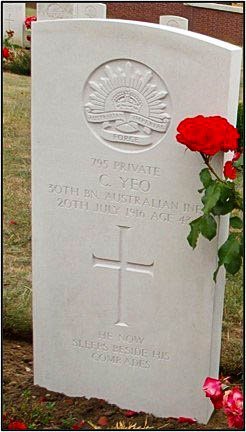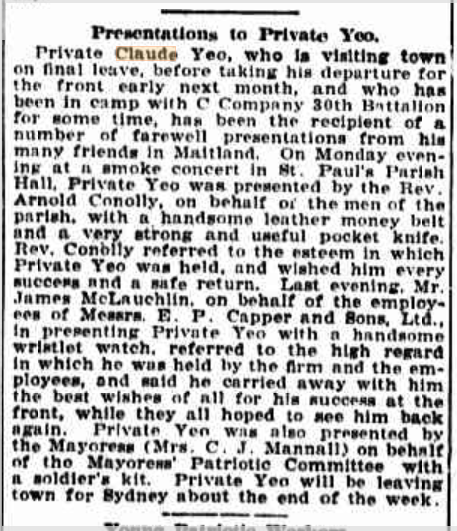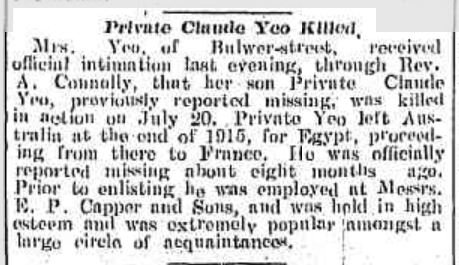
Claude Septimus Maitland YEO
Eyes blue, Hair light, Complexion medium
I’ll go if I can.
It was in these words that 42-year-old auctioneer Claude Yeo expressed his determination to ‘strike a blow for his country and for humanity’. He worked hard to be physically prepared and honed his rifle skills by attending weekly drills with the Citizens Rifle Reserve. He also took the liberty of lopping 4 years from his age claiming to be 38 when he enlisted in July 1915:
“He was full of dash, and bravo, and beneath that agile body, so full of vigour, there was much to be appreciated. There was a warmth of feeling which found its way to their hearts, and no one who had attended any of their social gatherings would forget him”.
Such was the local rector’s description of Claude Yeo - a man who filled no small place in the social life of their St Paul’s parish in Maitland. Having achieved his purpose and enlisted as a private, Claude embarked for Egypt and later France. Just twelve months later, Claude was reported missing at Fromelles and later found to have been killed in action on 20 July 1916.
Who was Claude Yeo?
Claude Septimus Maitland Yeo was the 8th of eleven children born to George and Betsy (nee Pender) Yeo on 29 December 1872 at Randwick. His father, George, was a livestock inspector and a highly successful stockbreeder who emigrated from Devon and settled and raised his large family in Maitland NSW until his death in 1891. Claude’s Scottish-born mother, Betsy, remained in Maitland until her death in 1923 and she was listed as his next of kin on enlistment.
Claude was educated at the Windsor Grammar school and, as a young man, went to the Western Australian goldfields with his older brother, Herb. Together they ran a thriving newsagency for some years. Herb married in 1903 and remained in Western Australia but Claude, who never married, returned to Maitland where he obtained his auctioneer’s licence and took up employment as a clerk and auctioneer with E.P. Capper and Sons. On enlistment, this firm presented Claude with a wristlet watch as a token of their high regard for him while St Paul’s parish held a smoke concert (a men-only social gathering) in his honour and gave him a handsome leather money belt and a pocketknife. The Mayoress of Maitland presented him with a soldier’s kit.
Claude’s time at war
It appears that Claude was a letter writer and that his large circle of family and friends wrote to him regularly. In fact, Red Cross records sadly refer to a whole packet of letters for Claude being unclaimed in mid July 1916.
Early in 1916, Claude wrote to the rector of his local parish, Rev. Arnold Conolly, and described a Communion Service held on New Year’s morning on the sands of Egypt just a few yards from enemy trenches. Claude described shaking hands with comrades in silent token of the season’s greetings and thinking what the year ahead may bring and how many more may be ahead for any of them. This reflection on the fragility of life on the battlefield was especially poignant when news came just months later that Claude was missing in action.
In June 1916, Claude left Egypt for France and would have soon been engaged on the Western Front, fighting at Fromelles less than a month later. A fellow private in the 30th Battalion, Stanley Stephens, wrote a rollicking yarn about his own part in the battle at Fromelles that was published in Maitland and other newspapers in December 1916. Stanley was described as a chum of Private Claude Yeo and it seems likely that he and Claude trained together in Sydney before embarking for Egypt and later France. While focused on his own part in the battle and his eventual escape, Stan described quite colourfully some of the events involving Claude:
“….In the trench Claude Yeo, myself and another boy were splashing in the water with the weight of our gear pressing us down into the mud. We turned back to the left and went back to where the others had disappeared. Then we saw what the others must have seen. We were in the German lines. We kept low for a while and then decided on another rush. It was wonderful the hundreds of rifles and machine guns levelled at only the three of us, and none of us scratched. Claude and I rushed into the trench and looked at one another (you can guess the sort of look).”
Later in the article, Stan noted that he only knew ‘about seven who got through unhurt’ and describes his last interactions with his chum, Claude:
“By this time we had no officers left in the trenches. About two or later in the morning a bomb came over the top and struck me in the back. However, I went on till about daylight. I threw 10 boxes of 15’s. I did not know I was hurt then, but I began to feel queer, so I went along the trench and sat down.”
Claude said: “Are you going to retire? I said No, just rest a minute. I think I went out for a few minutes then. When I woke up the trench seemed to be empty. Everyone was creeping over the parapet and leaving it. I had to get out too or get caught by the Germans. I never saw Claude or heard of him again. I would give something to know where he is. He may have caught the next bomb after mine, or he may have got away alright, but I could not find out.”
In April 1917, the army officially confirmed that Claude had been killed in action at Fromelles and, shortly afterwards, the family held a memorial service in his honour at St Paul’s Church.
News reports show that the service was very well attended and impressive in its tribute to the late Private Claude Yeo. It is not known what became of the watch, moneybelt and pocketknife presented to Claude in 1915 by his proud local community.
Presumably, he took these items with him when embarking from Sydney but correspondence between the family and the army indicate that after his death no personal effects were ever found to be returned to them.
Finding Claude
In recent years, members of his family have come forward yet again to pay respects to Claude by assisting with research, DNA testing and finally with arrangements for the dedication of Claude’s headstone once he was finally identified.
One family member in particular stepped out of her comfort zone to become a donor and helped complete the DNA identification picture. A researcher phoned her after being prompted to speak with a funeral director “who might know something”. The donor, in her senior years, was sensibly very cautious at being approached out of the blue about a soldier she knew nothing of, nor knew of any connection to his family.
The donor and researcher lived some distance apart so then began some months of phone calls and snail mail sharing of family information. Once convinced of the connection, the donor agreed to donate DNA. The researcher, by now quite fond of this beautiful lady, sensed her growing unease with the forthcoming DNA test, an unknown process about to be delivered to her mailbox.
Accordingly, the researcher drove some hours to be there at her home with flowers and reassurance to walk with her through the DNA kit process.
Such is the commitment of so many, many people to ensure these young soldiers of Fromelles are finally identified. This lovely donor also recognised the value of this work not just to her family but to many others and tried to offer a donation to assist. Knowing that, as a pensioner she had limited means, the researcher waved her offer away saying her involvement in the DNA identification process was enough. But she was adamant - such a determined and generous lady!
Laid to rest at last
Claude, finally identified in 2018, is now laid to rest at the Pheasant Wood Military Cemetery in Fromelles with his headstone at last bearing his name and an inscription reading:
“ He now sleeps beside his comrades “
Maitland Daily Mercury (NSW: 1894 - 1939), Friday 15 December 1916, page 7
IN THE GERMAN LINES
WONDERFUL ESCAPE
Private Stanley Stephens, a chum of Private Claude Yeo, of the 30th Battalion, who has been missing since July 20, writes:
You may have thought when you received the card that I was severely wounded, but I was not. I suppose you want to hear the story of the battle; you know we were in the trenches all the week before last. We were brought out on Sunday week as we thought, for a rest. Right up to Wednesday we were carrying ammunition of all descriptions to a section further along. All the time we were under shell fire. Several of the boys got knocked over. On Wednesday afternoon (19th) we were ordered to take the trenches opposite. Our artillery had been bombarding the German trenches all the week, but at midday Wednesday they opened out in earnest. and the Germans did likewise. Such a row you never heard. Shot and shell were flying everywhere, but doing very little damage on our side.
When the order was given to charge, at about 5.45, our artillery ceased, and the 31st and 32nd Battalions mounted the parapet and went over. Then our turn came, but we each had a certain amount of ammunition, so could not run so fast. We mounted the parapet and raced forward into a curtain of machine gun and rifle fire. Several of the boys fell, some never to rise again. We arrived at the first trench al-right, and then started for the second line. Somehow we must have turned slightly, for when we jumped into the next trench we were in water up to our chests. Then the officer shouted to turn to our right. The water became deeper, but we went on some distance, and when we turned, the others had gone over the parapet again and back, I think, except two who were shot there in the trench. As soon as they got in the open, the two officers who were with us were shot dead, so I heard afterwards.
In the trench Claude Yeo, myself, and another boy were splashing in the water with the weight of our gear pressing us down into the mud. We turned back to the left and went back to where the others had disappeared. Then we saw what the. others must have seen. We were in the German lines. We kept low for a while and then decided on another rush. It was wonderful the hundreds of rifles and ma chine guns levelled at only the three of us, and none of us scratched. Claude and I rushed into the trench and looked at one another (you can guess the sort of look). The third man was shot, through the leg, just as he reached shelter. We found we were still in the German lines, but the Germans had all cleared out. The trenches were lined with dead ones. Then we did not know where to go. We risked moving to the right. After bandaging up the other man's leg we had not gone far when we ran into our left barricade. We had not got through with the wounded man five minutes when the first bomb came — the Germans were back. That seems to be the way they fight now. They let you go as far as you like and then turn and drive you back. Of course, we cannot get ammunition up fast enough, as they make sure of those carrying it first.
As soon as that bomb came, I got to work, although I was told not to fight. For about ten hours I threw bombs amongst those Germans. Two or three of us held the left flank all night. When daylight came I could not believe it. By this time we had no officers left in the trenches. About two or later in the morning a bomb came over the top and struck me in the back. However, I went on till about daylight. I threw 10 boxes of 15's. I did not know I was hurt, then, but I began to feel queer, so I went along the trench and sat down. Claude said, 'Are you going to retire?’ I said 'No, just rest a minute.' I think I went out for a few minutes then. When I woke up the trench seemed to be empty.
Everyone was creeping over the parapet and leaving it. I had to get out, too, or get caught by the Germans. I never saw Claude or heard of him again. I would give something to know where he is. He may have caught the next bomb after mine, or he may have got away alright, but I could not find out. I crawled over to our trenches. This was the fifth time I had gone through a curtain of fire unscathed. Then the Germans attempted to come across to our trenches, so I had to stand to for an hour and work the rifle. Then I sat down against the wall for an hour and could not get up the ambulance had to remove me. I only know about seven who got through unhurt. There may have been more, but I went away with the wounded in the motor car that night. There were thousands of wounded sailing from Boulogne to Birmingham.
The Fromelles Association would love to hear from you

Contacts
(Contact: carla@fromelles.info or geoffrey@fromelles.info).
(Contact: army.uwc@defence.gov.au or phone 1800 019 090).
Donations
If you are able, please contribute to the upkeep of this resource.
(Contact: bill@fromelles.info ).

